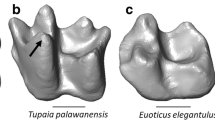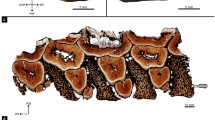Abstract
Dental characteristics figure large in primate taxonomy because teeth fossilize commonly and reflect dietary adaptations. The mammalian dentinoenamel junction (DEJ) plays a crucial role throughout odontogenesis in determining the ultimate crown configuration, being the interface between the papilla and the dental cap. The final configuration of the dentin surface reflects the epithelium more closely than does the enamel surface of the crown. Enamel deposition occurs relatively late in calcification, often causing many changes from the pattern residing in the DEJ; the genetic determination of the two surfaces also differs. Comparative study of the DEJ (and its differences from the enamel crown) is a potential adjunct to dentition-based taxonomy and may help to resolve certain cusp homologies and morphogenetic order of appearance. Primate teeth were stripped of enamel after measurement, mapping, and anatomical observations on the original crown. The dentin surfaces thus revealed differ from the enamel surfaces in several respects and shed new light on such dental problem areas as the origin of the hypocone, the affinities of lorisoids and callitrichids, the monophyly of the anthropoid grade, and human affinities.
Similar content being viewed by others
References
Achermann, M. (1970). Vergleich des rÄumlichen Verhaltens von Schmelzmit Dentin-Kronenrelief im Dauergebiss der Katz.Rev. Suisse Zool. 77: 877–893.
Alberch, P. (1985). Problems with the interpretation of developmental sequences.Syst. Zool. 34: 46–58.
Biggerstaff, R. H. (1969). The basal area of posterior tooth crown components: The assess-ment of within-tooth variations of premolars and molars.Am. J. phys. Anthrop. 31: 163–170.
Biggerstaff, R. H. (1975). Cusp size, sexual dimorphism, and heritability of cusp size in twins.Am. J. phys. Anthrop. 42: 127–140.
Butler, P. M. (1956). The ontogeny of molar pattern.Biol. Rev. 31: 30–69.
Butler, P. M. (1967). Dental merisms and tooth development.J. dent. Res. 46: 845–850.
Butler, P. M. (1980). The tupaiid dentition. In Luckett, W. P. (ed.),The Comparative Biology and Evolutionary Relationships of Tree Shrews, Plenum, New York, pp. 171–204.
Christenson, G. J. (1967). Occlusal morphology of human molar tooth buds.Arch, oral Biol. 12: 141–149.
Christensen, T. J., and Kraus, B. S. (1965). Initial calcification of the human permanent first molar.J. dent. Res. 44: 1338–1342.
Corruccini, R. S. (1977). Cartesian coordinate analysis of the hominoid second lower deciduous molar.J. dent. Res. 56: 699.
Corruccini, R. S. (1981). Analytical techniques for Cartesian coordinate data with reference to the relationship betweenHylobates andSymphalangus.Syst. Zool. 30: 32–40.
Corruccini, R. S. (1982). The dentino-enamel junction and primate taxonomy.J. dent. Res. 61: 312.
Dahlberg, A. A. (1971). Penetrance and expressivity of dental traits. In Dahlberg, A. A. (ed.),Dental Morphology and Evolution, University of Chicago Press, Chicago, pp. 257–262.
Delson, E. (1975). Evolutionary history of the Cercopithecidae.Contr. Primatol. 5: 167–217.
Delson, E. (1977). Catarrhine phylogeny and classification: Principles, methods and comments.J. hum. Evol. 6: 433–459.
Delson, E., and Andrews, P. (1976). Evolution and interrelationships of the catarrhine primates. In Luckett, W. P., and Szalay, F. S. (eds.),Phylogeny of the Primates, Plenum, New York, pp. 405–446.
Delson, E., Eldredge, N., and Tattersall, I. (1977). Reconstruction of hominid phylogeny: A testable framework based on cladistic analysis.J. hum. Evol. 6: 263–278.
Duss, W. (1963). Vergleich des rÄumlichen Verhaltens von Dentinkronenrelief and Schmelzrelief der MilchzÄhne.Acta anal. 52: 101–136.
Eldredge, N., and Tattersall, I. (1975). Evolutionary models, phylogenetic reconstruction, and another look at hominid phylogeny.Contr. Primatol. 5: 218–242.
Faller, A., and Nager, G. (1960). Zur Kenntnis des OberflÄchenreliefs der Dentinkronen menschlicher ZÄhne.Acta anat. 41: 345.
Gillings, B., and Buoncore, M. (1961). Thickness of enamel at the base of pits and fissures in human molars and bicuspids.J. dent. Res. 40: 119–133.
Gingerich, P. D. (1975). A new genus of Adapidae (Mammalia, Primates) from the late Eocene of southern France, and its significance for the origin of higher primates.Contr. Mus. Paleo. Univ. Mich. 24: 163–170.
Gould, S. J. (1977).Ontogeny and Phylogeny, Harvard University Press, Cambridge, Mass.
Kay, R. F. (1975). The functional adaptations of primate molar teeth.Am. J. phys. Anthrop. 43: 195–216.
Kay, R. F. (1977). The evolution of molar occlusion in the Cercopithecidae and early catarrhines.Am. J. phys. Anthrop., 46: 327–352.
Kimura, O., Dykes, E., and Fearnhead, R. W. (1977). The relationship between the surface area of the enamel crowns of human teeth and that of the dentine-enamel junction.Arch, oral Biol. 22: 677–683.
Knecht, H. (1965). Vergleich des rÄumlichen Verhaltens von Dentinkronenrelief und Schmelzrelief im Rattengebiss.Anat. Anz. 116: 59–72.
Kollar, E. J. (1975). Gene-environment interactions during tooth development.Dent. Clin. N. Am. 19: 141–150.
Korenhof, C. A. W. (1960). Morpho-genetical aspects of the human upper molar. A comparative study of its enamel and dentine surfaces and their relationship to the crown pattern of fossil and Recent Primates.Biol. Abstr. 36: 50904.
Kraus, B. S. (1952). Morphologic relationships between enamel and dentine surfaces of lower first molar teeth.J. dent. Res. 31: 248–256.
Kraus, B. S. (1959). Differential calcification rates in the human primary dentition.Arch, oral Biol. 1: 133–144.
Kraus, B. S., and Jordan, R. E. (1965).The Human Dentition Before Birth, Lea and Febinger, Philadelphia.
Krogman, W. M. (1967). The role of genetic factors in the human face, jaws and teeth: A review.Eugen. Rev. 59: 165–192.
Nager, G. (1960). Der Vergleich zwischen dem rÄmlichen Verhalten des Dentinkronenreliefs und dem Schmelzrelief der Zahnkrone.Acta anat. 42: 226–250.
Oka, S. W., and Kraus, B. S. (1969). The circumnatal status of molar crown maturation among the hominoidea.Arch, oral Biol. 14: 639–659.
Rosenberger, A. L. (1977).Xenothrix and ceboid phylogeny.J. hum. Evol. 6: 461–481.
Sakai, T. (1967). Morphologic study of the detinoenamel junction of the mandibular first premolar.J. dent. Res. 46: 927–932.
Sakai, T., and Hanamura, H. (1973.) A morphological study of enamel-dentin border on the Japanese dentition. VI. Mandibular molar.J. anthrop. Soc. Nippon 81: 25–45.
Sakai, T., Sasaki, I., and Hanamura, H. (1965). A morphological study of enamel-dentin border on the Japanese dentition. I. Maxillary median incisor.Zinruigaku Zassi 73: 91–109.
Sakai, T., Sasaki, I., and Hanamura, H. (1967a). A morphological study of enamel-dentin border on the Japanese dentition. II. Maxillary canine.Zinruigaku Zassi 75: 155–172.
Sakai, T., Sasaki, I., and Hanamura, H. (1967b). A morphological study of enamel-dentin border on the Japanese dentition. III. Maxillary premolar.Zinruigaku Zassi 75: 207–223.
Sakai, T., Sasaki, I., and Hanamura, H. (1969). A morphological study of enamel-dentin border on the Japanese dentition. IV. Mandibular premolar.J. anthrop. Soc. Nippon 77: 71–98.
Sakai, T., Sasaki, I., and Hanamura, H. (1973). A morphological study of enamel-dentin border on the Japanese dentition. VII. General conclusion.J. anthrop. Soc. Nippon 81:87–102.
Schaeffer, B., Hecht, M. K., and Eldredge, N. (1972). Phylogeny and paleontology.Evol. Biol. 6: 31–46.
Schwartz, J. H. (1974). Observations of dentition of the Indriidae.Am. J. phys. Anthrop. 41: 107–114.
Schwartz, J. H. (1975). Re-evaluation of the morphocline of molar appearance in the primates.Folia primatol. 23: 290–307.
Schwartz, J. H. (1978). Homologies of the toothcomb.Am. J. phys. Anthrop. 49: 23–29.
Sela, J., Sela, M., Lustmann, J., and Ulmansky, M. (1975). Dentinoenamel junction area of a resorbing permanent incisor studied by means of scanning electron microscopy.J. dent. Res. 54: 110–113.
Sieben, J. R., and Swindler, D. R. (1985). Ontogenetic changes in the chimpanzee dentition.Am. J. phys. Anthrop. 66: 228.
Simons, E. L. (1965). New fossil apes from Egypt and the initial differentiation of Hominoidea.Nature (London) 205: 135–139.
Simons, E. L. (1972).Primate Evolution, Macmillan, New York.
Sneath, P. H. A. (1967). Trend-surface analysis of transformation grids.J. Zool. 151: 65–122.
Staley, R. N. (1968). Dentin crown surface of human adult incisor teeth.J. dent. Res. 47: 824–828.
Stern, D., and Skobe, Z. (1985). Individual variation in enamel structure of human mandibular first premolars.Am. J. phys. Anthrop. 68: 201–213.
Swindler, D. R., and Orlosky, F. J. (1974). Metric and morphological variability in the dentition of colobine monkeys.J. hum. Evol. 3: 135–160.
Szalay, F. S. (1969). Mixodectidae, Microsyopidae and the insectivore-primate transition.Bull. Am. Mus. nat. Hist. 140: 193–330.
Szalay, F. S., and Delson, E. (1980).Evolutionary History of the Primates, Academic Press, New York.
Urscheler, O. (1976). Vergleich des rÄumlichen Verhaltens von Schmelz- und Dentin-kronerelief vonCercopithecus aetiops pygerytrus (Meerkatze, Vervet monkey).Rev. Suisse Zool. 83: 423–442.




